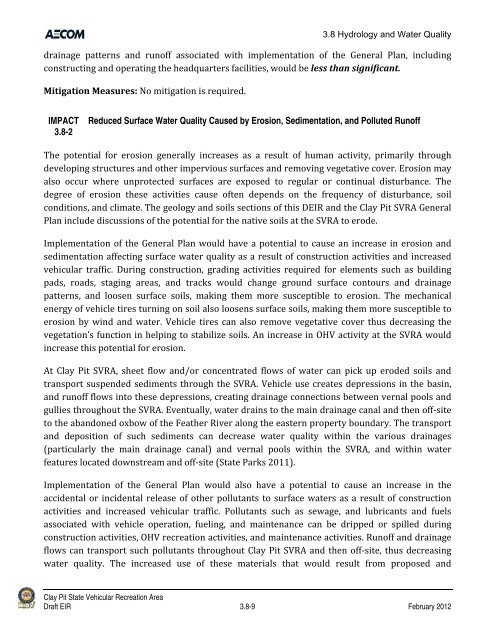Draft Environmental Impact Report - California Off Highway Vehicle ...
Draft Environmental Impact Report - California Off Highway Vehicle ...
Draft Environmental Impact Report - California Off Highway Vehicle ...
You also want an ePaper? Increase the reach of your titles
YUMPU automatically turns print PDFs into web optimized ePapers that Google loves.
3.8 Hydrology and Water Quality<br />
drainage patterns and runoff associated with implementation of the General Plan, including<br />
constructing and operating the headquarters facilities, would be less than significant.<br />
Mitigation Measures: No mitigation is required.<br />
IMPACT<br />
3.8-2<br />
Reduced Surface Water Quality Caused by Erosion, Sedimentation, and Polluted Runoff<br />
The potential for erosion generally increases as a result of human activity, primarily through<br />
developing structures and other impervious surfaces and removing vegetative cover. Erosion may<br />
also occur where unprotected surfaces are exposed to regular or continual disturbance. The<br />
degree of erosion these activities cause often depends on the frequency of disturbance, soil<br />
conditions, and climate. The geology and soils sections of this DEIR and the Clay Pit SVRA General<br />
Plan include discussions of the potential for the native soils at the SVRA to erode.<br />
Implementation of the General Plan would have a potential to cause an increase in erosion and<br />
sedimentation affecting surface water quality as a result of construction activities and increased<br />
vehicular traffic. During construction, grading activities required for elements such as building<br />
pads, roads, staging areas, and tracks would change ground surface contours and drainage<br />
patterns, and loosen surface soils, making them more susceptible to erosion. The mechanical<br />
energy of vehicle tires turning on soil also loosens surface soils, making them more susceptible to<br />
erosion by wind and water. <strong>Vehicle</strong> tires can also remove vegetative cover thus decreasing the<br />
vegetation’s function in helping to stabilize soils. An increase in OHV activity at the SVRA would<br />
increase this potential for erosion.<br />
At Clay Pit SVRA, sheet flow and/or concentrated flows of water can pick up eroded soils and<br />
transport suspended sediments through the SVRA. <strong>Vehicle</strong> use creates depressions in the basin,<br />
and runoff flows into these depressions, creating drainage connections between vernal pools and<br />
gullies throughout the SVRA. Eventually, water drains to the main drainage canal and then off‐site<br />
to the abandoned oxbow of the Feather River along the eastern property boundary. The transport<br />
and deposition of such sediments can decrease water quality within the various drainages<br />
(particularly the main drainage canal) and vernal pools within the SVRA, and within water<br />
features located downstream and off‐site (State Parks 2011).<br />
Implementation of the General Plan would also have a potential to cause an increase in the<br />
accidental or incidental release of other pollutants to surface waters as a result of construction<br />
activities and increased vehicular traffic. Pollutants such as sewage, and lubricants and fuels<br />
associated with vehicle operation, fueling, and maintenance can be dripped or spilled during<br />
construction activities, OHV recreation activities, and maintenance activities. Runoff and drainage<br />
flows can transport such pollutants throughout Clay Pit SVRA and then off‐site, thus decreasing<br />
water quality. The increased use of these materials that would result from proposed and<br />
Clay Pit State Vehicular Recreation Area<br />
<strong>Draft</strong> EIR 3.8-9 February 2012








